![]()
RHUM EXPEDITION 1976
Leader: Roger Weatherly
Camp Administrator: Nick Deeley
Members: Nick Caplin, Tim Chadwick, Dick Light, Phil and Lyn Renold, John Courtman, David Deeley, David Ellis, Colin Gilbert.
Gavin Gordon. Paul Hillman, Mark Hopwood. Neil Hyde. Richard (Benje) Lovelock, David Morley, Martin Oetiker, Richard (Emu) Owen,
Stephen Paynter, Chris Price, Nick Showan, Nick Smith, Patrick Thompson, Chris Venning. And special guest Launcelot Fleming.
LEADER'S REPORT
|
Leading an expedition to Rhum is rather like getting a free pass into Heaven - nothing can possibly go wrong.... once you get there. For aboard the elderly and laden MacBraynes vessel out of Mallaig it was far from plain sailing. "Excuse me Sir....” a discrete word in the left ear " I wonder if you would mind moving your party to the other side of the boat? They seem to have given us a noticeable list." Such is the impact of the Society on the Hebrides. On a more serious note we would do well to remember the effect we have on an island like Rhum which has thirty inhabitants, a full programme of research to undertake in a short summer, and a deer cull to fit around the visitors. he Chief Warden ,Mr Corkhill. and all his staff were incredibly generous with practical assistance, time, advice, good humour, and we thank them all. Truly what we found on Rhum would not have been possible without them. Nearly everyone knows something of Rhum. The surrealistic castle, the high demanding craggy Cuillins, the magnificent deer, the beaches. But who would have thought that we would find temperatures in the 60's. clear skies, five minutes rain in three weeks, and eventually a water shortage. When we started we all rushed from peak to peak In case the weather broke. But when it didn't we could be sometimes seen looking anxiously towards Skye ,through the heat haze to check in case someone had towed our island southwards to the Canaries.we were a large party for a senior expedition, and I waft delighted as It seamed everyone accepted the slight restraints that numbers imposed on us. Camp chorea and the cooking were enthusiastically handled, walkers happily accommodated larger parties than usual, and the turnaround speed of bivvy equipment was stunning. All this was with only three officers at the start, for sadly Mark Rayne and Stuart Fry suffered personal emergencies which prevented them departing with us. Phil and Lyn Renold came to swell the ranks, and throughout expedition members seemed to initiate, fill leadership gaps, and improvise, officers or not. In fact "Your kindness was only exceeded….", so you have guessed who else was there? Launcelot - who arrived for five days at the end, and so greatly enriched us with his company in spite of the kilt. (I wipe my dipstick with a better rag.) |
|
So what did we do? For the most part this was an activity expedition. The great ridge walk was completed in both directions, involving a 5.50 am start to avoid the afternoon heat. There were so many civvies we lost count. There were six to the bird hut on Hallival for a start. We did a slope analysis survey, a settlement study, two biological projects, a good deal of climbing, played rugby on the beach at Kilmory, and of course swam. We returned the kindness of the Nature Conservancy by twice weeding at Guirdil, and helping with a fencing project on the north side of the island. But there were other less tangible things- the extremely frank discussions some evenings when we learned to listen to each other, the nocturnal snipe at the camp site, canoeing on Long Loch, and soaking up the stillness, and of course the castle .. that time machine building, uncanny, incongruous, Edwardian, vital. I am left thankful for August 1976- for the weather, that wild beautiful island, the Conservancy staff, the SHS executives and directors, and the members of the expedition itself. The experience was a privilege that will live on for all of us. ROGER WEATHERLY |
|
The last of the S.H.S trips I went on - reputed to be to one of the wettest places in the UK, visited during the year that Denis Howell was appointed Minister for Drought because it was the driest summer in 200 years, and that is much as I remember it. It is the only time I suffered sun stroke in Scotland. For reasons best known to myself, in the case of Rhum I will use either spelling, it is now called Rům. It is thought that George Bullough, the wealthy industrialist who owned the island in the late 19th and early 20th century, changed the island's original Gaelic name from Rum to Rhum because he didn't want the island associated with the alcoholic drink and it was then changed back to its original name in 1991 by the then Nature Conservancy Council. The expedition was for the 17+ age group, I'd left school and was working and like several others had a driving licence. Consequently Nick Showan and I travelled up to Scotland in Chris Price's Austin 1100, parking on the seafront at Mallaig prior to joining the rest of the group and getting the ferry to Rhum. I don't have any recollections of the journey to Mallaig but we did have a few issues on the way home. The car wouldn't start after being left for 2 weeks, and later, on the motorway home we tried to purchase petrol asking if we could use a cheque without a guarantee card at a couple of garages without success until finally at the 3rd we filled up and just presented the cheque. The poor woman attendant didn't want to accept the cheque but as we didn't have any cash and she wasn't prepared to siphon the petrol out, had no choice. Problem solved. |
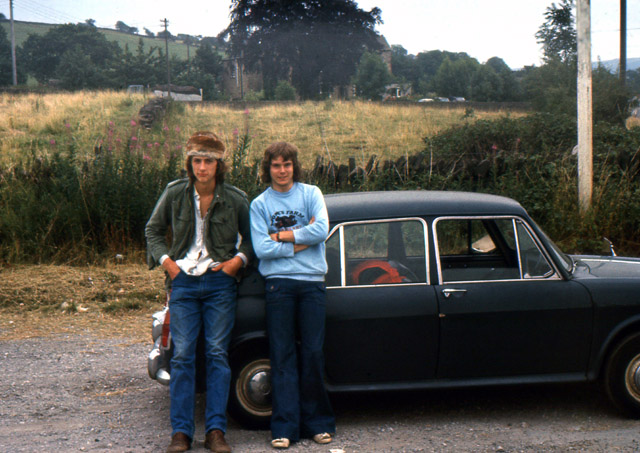 |
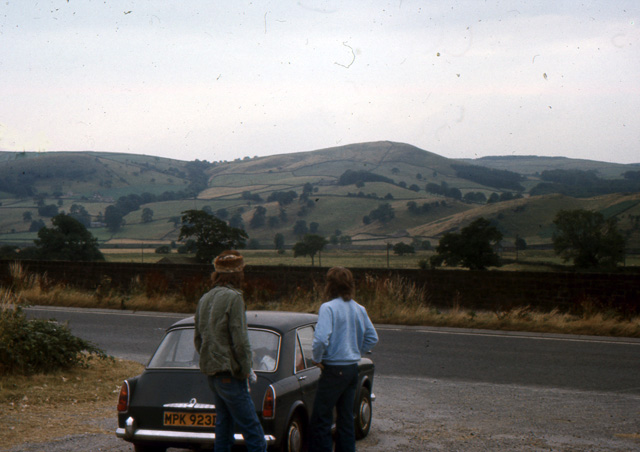 |
| The trip across to Rhum was quite spectacular, the weather was beautiful so the islands were very clear. The photo on the left shows the steep sea cliffs of Eigg as the small CalMac ferry passes by, and on the right the mountainous view of Rhum with its peaks of Hallival (723m), Askival (812m), Ainshval (778m) and Orval. | |
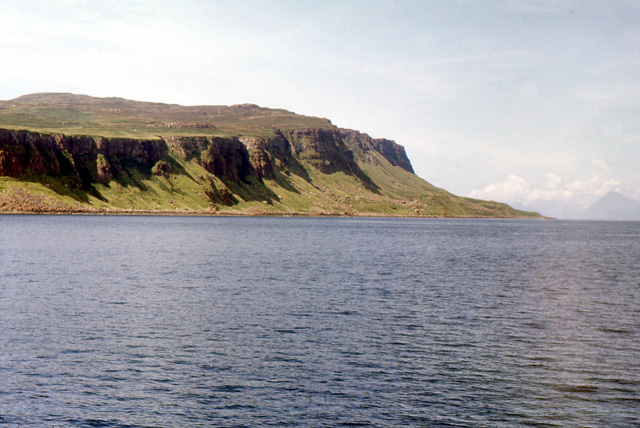 |
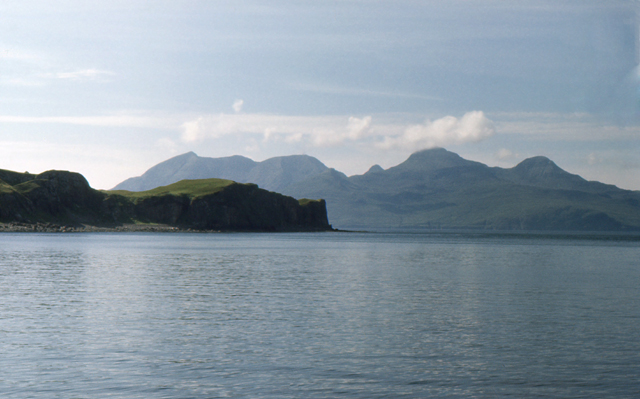 |
|
The harbour in Loch Scresort at Kinloch wasn't deep enough to receive the ferry if my memory is correct, so we had to transfer to a smaller boat just offshore. I can't picture how all the gear was transferred but I'm sure that is what happened, I also don't remember the transportation of the equipment to the campsite but I have photos of it coming back by tractor and trailer at the end of the trip so presumably it went there the same way. The campsite was pretty much in the centre of the island on flat ground near Salisbury's Dam, rather the remains of it, because the dam burst very shortly after it had been completed in August 1854, sending a torrent of water down Kilmory Glen. |
|
|||||||
|
A view from near the shearwater hut on the slopes of Hallival at about 370 meters, with clear views of the island of Eigg to the south east. The manx shearwaters nest in burrows slighly higher up the slope, they are extremely noisy at their colonies after dark, calling to their mates to ensure they return to the correct burrow. The call is a very strange noise and when you are on the upper reaches of a mountain on a dark night they are really quite eerie. If you don't believe me click here to listen to the sound of a shearwater calling. Having walked to the hut you have to wait for it to get properly dark before the shearwaters return to their burrows, so we made a meal and sat around chatting. Eventually we could hear the shearwaters calling and made our way up to the slopes where they were. With a torch you could easily spot the birds coming out of their burrows. |
| The birds come in at night because they make easy prey for predatory birds and one of our group, John or Richard was convinced they heard a swooping sound of a large bird of prey trying to take a flying shearwater, hopefully one of them will confirm that. | ||
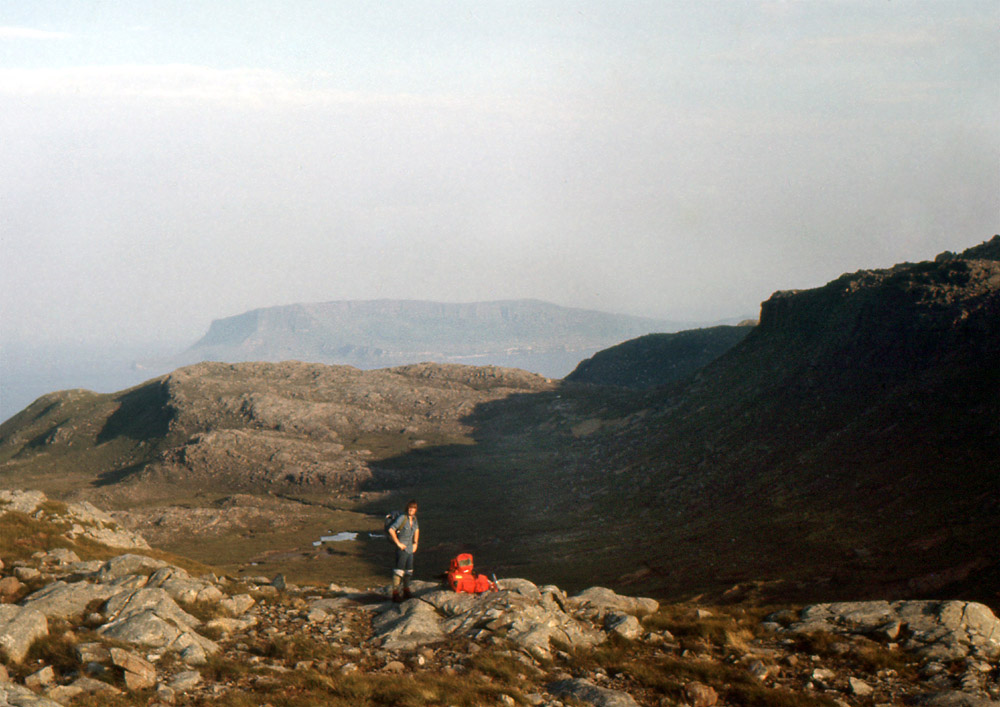 |
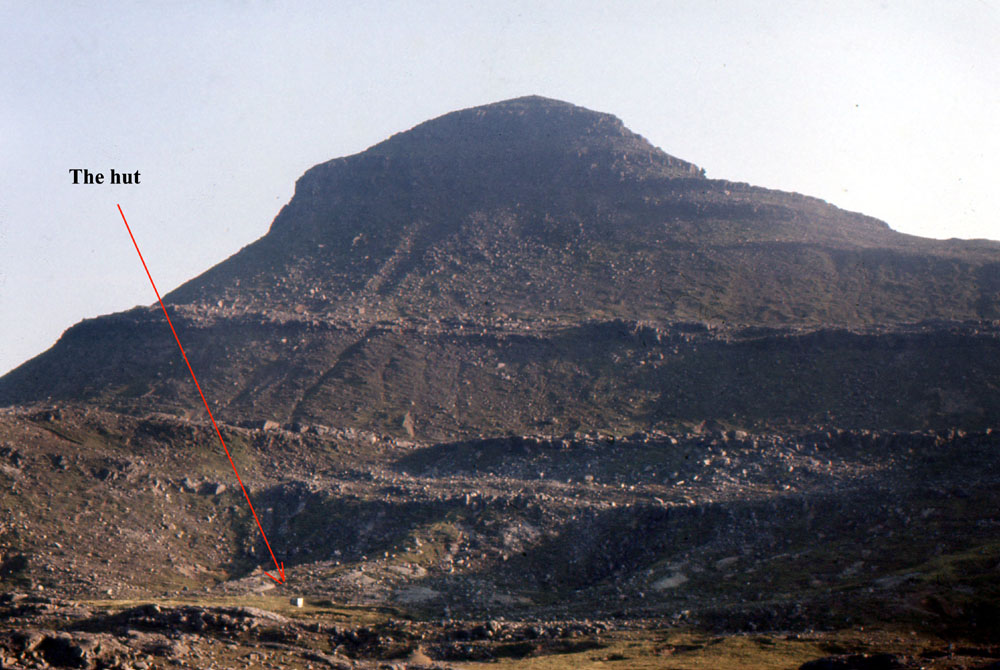 |
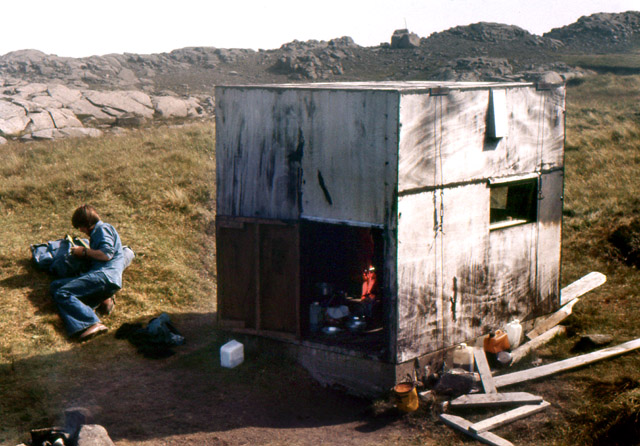 |
|
John Courtman heading up Hallival towards the accommodation for the night |
The 'shearwater hut', dwarfed by Hallival, it would be quite difficult to find in poor visibility. | The bijou residence for the 3 or 4 of us. |
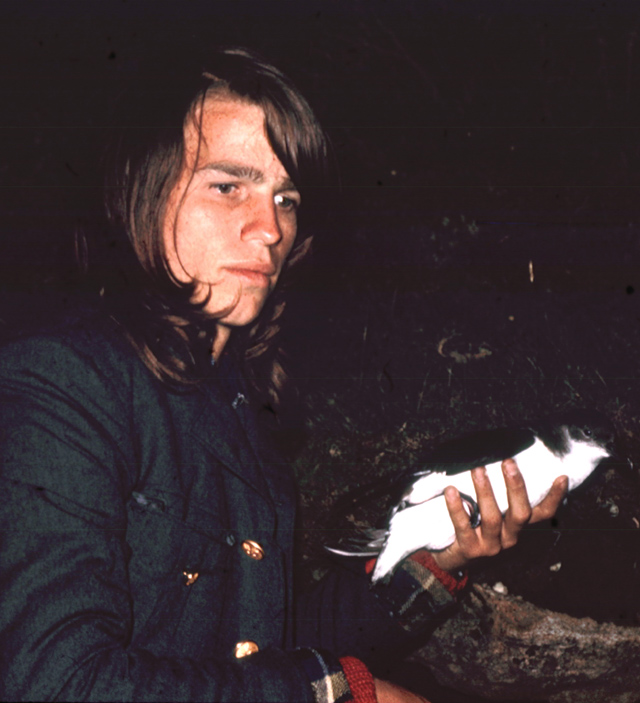 |
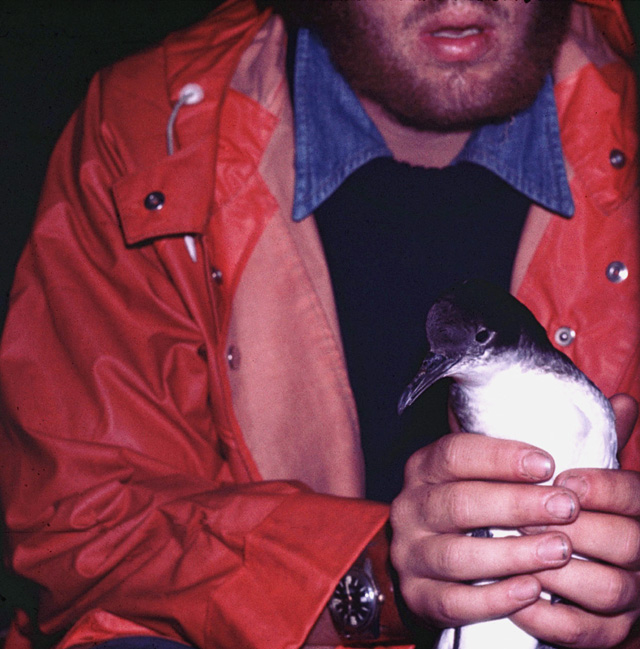 |
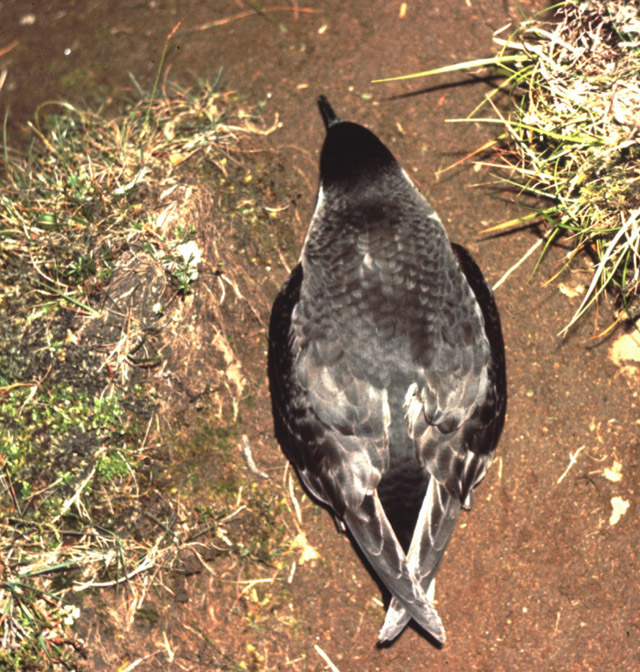 |
|
The stars of the show, the shearwaters with (L) Richard Owen and (centre) with John Courtman and (R) one on its own. |
||
|
I think it is about time to mention one of the expedition members shown on the list above, Rt. Rev. Launcelot Fleming, not a typical officer of the S.H.S, he was an honorary advisor to the society, he had been a chaplain to successive Antarctic expeditions including the British Graham Land expedition between 1934 and 1937 for which he was awarded the Polar Medal in 1937. I suggest you do your own search on him as there is too much to include here, but needless to say he was a lovely character with many tales to tell and for him at least, Long Loch must have seemed like a warm bath compared to his early experiences. According to references on the internet he was born in 1906 so at the time of the Rum expedition he was 70 but this didn't deter him from taking a swim in the loch whenever possible. In the same year as the Rum trip he was awarded an honorary doctorate by the University of East Anglia for his work with young people. On resigning his bishopric, Fleming was appointed the Queen's domestic chaplain and Dean of Windsor, in which capacity he officiated at the funeral of the Duke of Windsor. So, now to the trip to the west of the island and the mausoleum at Harris. I think it must have been a bivouac for the same reasons I have given elsewhere, it was too far to travel there and back in a day but looking at the map it is only about 4 miles along a track so it would be perfectly feasible to do that in a day. However the photographs I have show us there certainly in the late afternoon and we have a big cooking pot on the fire which would have been an unnecessary burden to carry for a day trip but I don't remember putting up tents? So, one morning we set out, I remember Richard Owen finding an interesting spider - or maybe just a big spider, and telling us about the life of arachnids, how they can survive without food or water for some time (I remember the conversation but not the detail, story of my life!). On the route to Harris we had to pass the cages housing the sea eagles which were being 'acclimatised' so that when they were released into the wild they would recognise their surroundings. We'd been given strict instructions not to disturb them but because I had a telephoto lens I got some great shots of them from the track - or so I thought. When I got home and had the film developed (yes, in those days we had to send the film off to be developed) it was blank, it hadn't been wound onto the spool properly and so had never been exposed, - no photos. We arrived at the mausoleum, the tomb to mark the burial of George Bullough, the former owner of the island. The photos for this are on the same roll of film as the sea eagles, lucky I wasn't a wedding photographer. At some point I must have changed the film because there are photos of us larking about on the beach at Harris, including the Viking trio below, (it seemed an appropriate use of various bits of metal fishing net floats found on the beach) and the group of us being silly by the camp fire. For the latter photo I placed the camera on the rocks above, set the timer and ran down to join everyone, but just before I got there they ran off! |
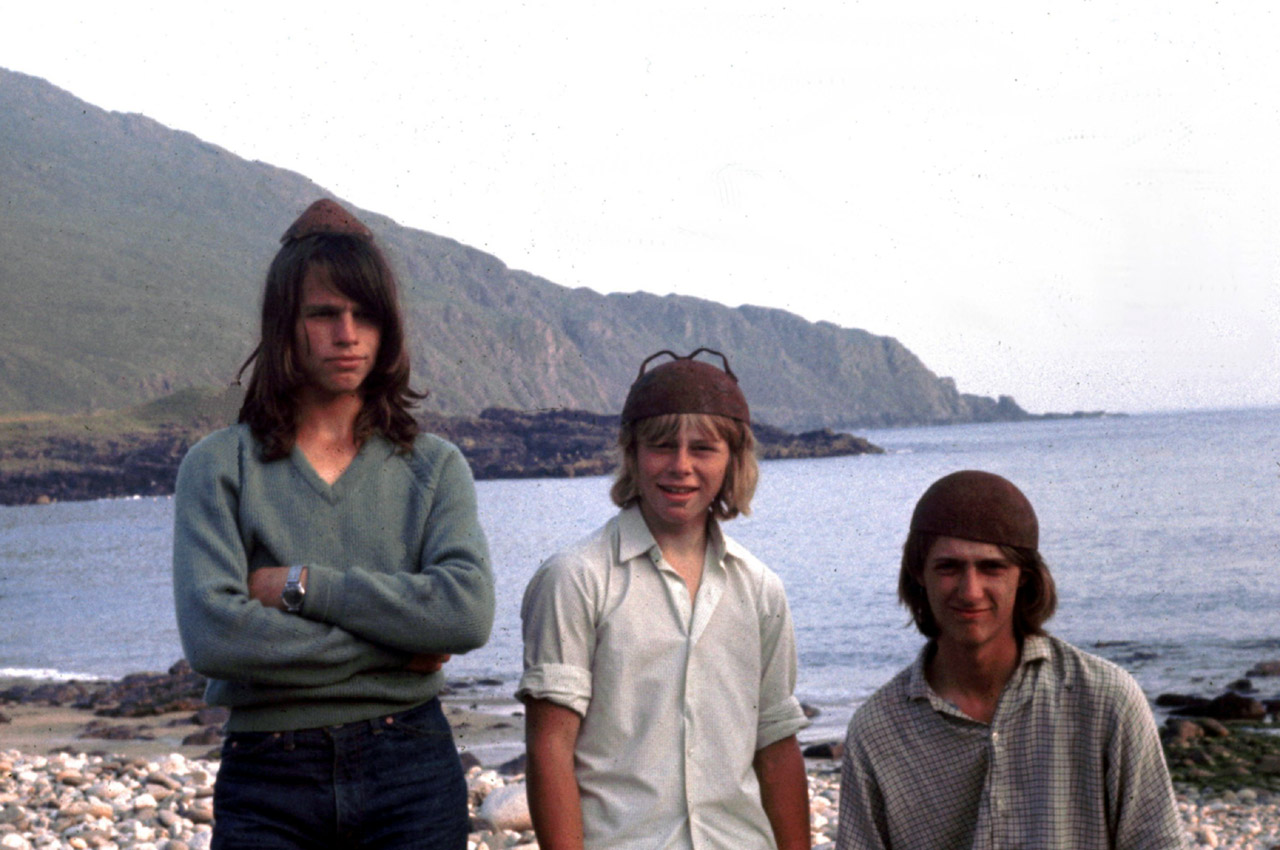 Richard Owen, standing, Paddy Thompson, standing, Nick Showan, seated |
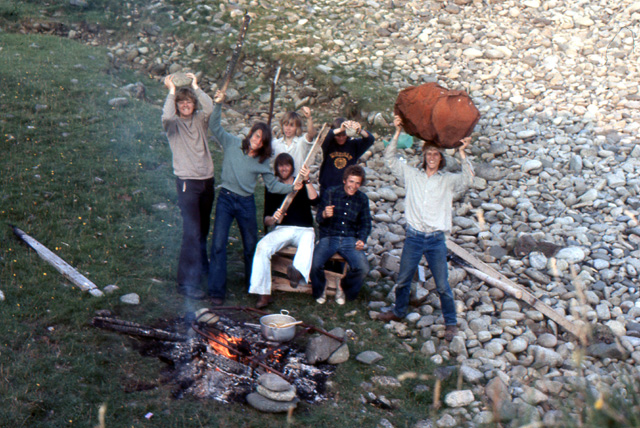 Nick Smith, Richard Owen, John Courtman (f) Paddy Thompson (b) Benje Lovelock (f) Chris Price (b) Nick Showan |
|
Also at Harris beach, we decided to cool off in the little stream that empties into the bay there, it was absolutely freezing. So we decided that the 'warm waters' of the Gulf Stream would probably be warmer than the cold mountain stream - we were wrong, the sea was definitely colder, to the point where we soon dashed out and washed the salty water from our bodies in the stream, which now seemed almost luxuriously warm in comparison. I think we were just soft! |
| A few more recollections
later, first here is a group photo taken against Salisbury Dam near the
campsite. I've created a separate page for this photo and a numbered copy to see
if I can get everyone named on it .
Click Here
and see if you can identify anyone.
|
|
And now for Kinloch Castle, I'd forgotten this bit until I'd had an e-mail from Dave Deeley though. He, and I'm sure I, together with a couple of others had walked down to Kinloch for some reason, possibly to go to the little shop and post office. At some point while there, we were invited to go in and have a look around Kinloch Castle. We had a guided tour all around, and I'm remembering 'early double glazing', 'one of the first private hydroelectric power generators' driven by the stream running past the castle, the elaborate shower bath and not forgetting the organola as I saw it described somewhere, also called the 'Orchestrion'. This mechanical pianola was built into a cupboard or under the stairs, it was fired up for us and I still remember it blasting out the finale of Rossini's William Tell overture, it was designed to replicate a 40 piece orchestra, for further information and a photo see below. |
|
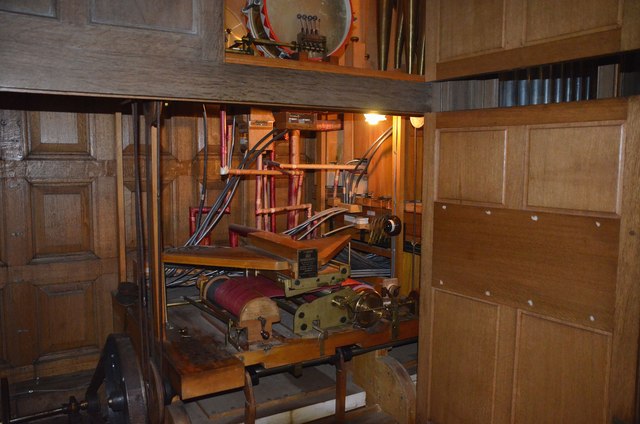 |
The photo of the bath is the one I took in 1976, it is a conventional bath in one direction and a multi fa(u)ceted! shower cubicle perpendicular to it with a range of jets and sprays |
|
Above © Copyright Jim Barton "The ultimate development of the pianola system to play by machinery a set of instruments to represent a 40-piece orchestra. The music is stored on a paper drum which unwinds through the playing mechanism, controlling levers and bellows operating a pipe organ, percussion and other instruments. Sir George Bullough bought this in 1906 and it is now thought to be one of only two examples still in working order." |
|
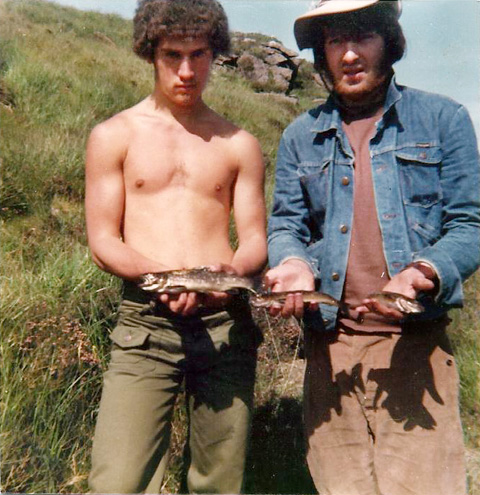 |
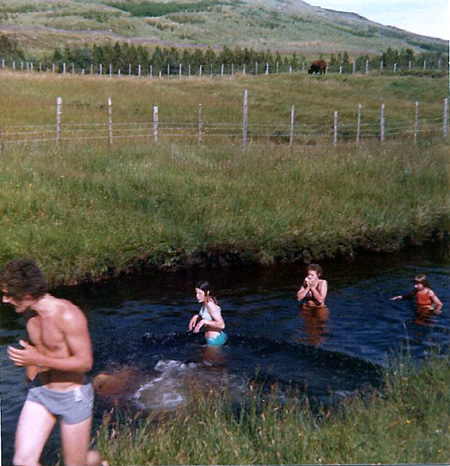 |
|
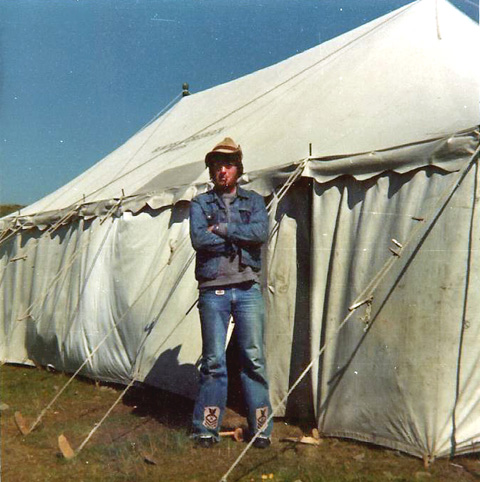 |
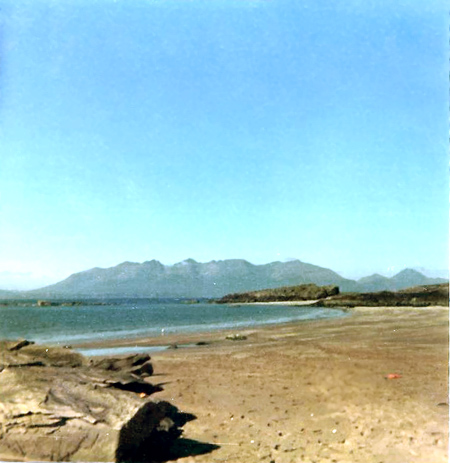 |
 |
|
"Do you remember on Rhum my brother sent me a tin of Danish butter which was worth its weight in gold except that the climbing instructor (also in the photos but whose name I forget) climbed up a telegraph pole and stuck it up there. It took ages to get it down but was worth the weight (pun). I seemed to make friends quite quickly after repossessing that tin!" And later...."I must be getting my wires crossed. Nick (Deeley) was on Rum so he couldn't have sent me a tin of butter. I must have been on another expedition when that happened. I spotted Paddy Thompson on one of your photos - he's the little lad in the pic of 3 people [see above] He has long blonde hair and a 'skull cap' on. He was a Scot and the son of a famous ornithologist in Sutherland. It was he and I that caught a salmon by hand from the brook that ran through the campsite. There were two guys from Leicester and the other one is the short cropped blond kid (all these blondes) on the photo where I'm in a red cagoule [On the South Uist 1975 trip, half way down the page]. They were a mad pair. They introduced murder ball to us all - do you remember the game"? [ I didn't until you said, but now there are photos from Alan Evison of the game, it was South Uist 1975, see the 'slide show' group of photos use the browser back button to get here again- I'll have to find a better way of displaying them.] "The web site photos show the camp site at Rum by the dam which burst and trashed the green houses at Kinloch castle. ps - 4 of us jumped ship and went to the castle on our own and got a guided tour, only to find out an official tour was arranged the next day. It was very embarrassing to have to go back and listen again, pretending we hadn't been. Don't know what the guide thought but he didn't say anything. Were you one of the 4 that went early?" [See Nick Showan's comments above, how the mind plays tricks, it can't all be right, if you were there do you remember the girl with the horse?] |
||||||||||||||||||||||||||||||||||||||||||||
And thanks to
Richard Owen who sent the following photos.
|
||||||||||||||||||||||||||||||||||||||||||||
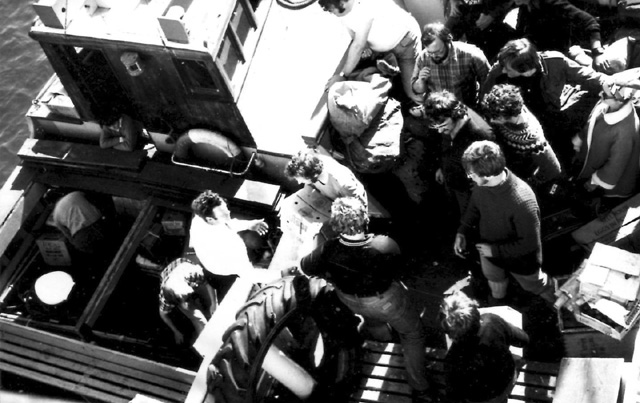
This one from Ben Buxton, although not
on this trip he happened to be on the same ferry! "As to my solo
wanderings in the islands, it's complicated! I travelled to Reinigeadal 74 with
everyone but stayed on at the end and went up to Lewis and then down the chain
to Barra. In 75 I hitched up to Mallaig - that was when John Hutchinson stopped
and gave me a lift from Fort William to Mallaig - and spent 6 weeks wandering
around Lewis and Harris and then went down to Mingulay for both camps. In 76 I
got the ferry from Oban to Barra, and the North Uist expedition happened to be
on it. I talked to the leader Alan Fowler and a week later on my way
through the Uists I walked to the camp and up Eaval with some of them (carrying
my rucksack with all my camping gear in it!). I went to Reinigeadal when the SHS
were there, and on my way south I decided to do the Small Isles cruise on the
ferry, which the Rum expedition happened to be on!"
More photos soon